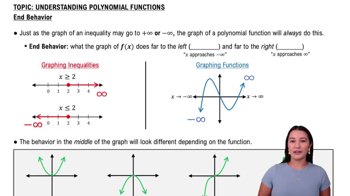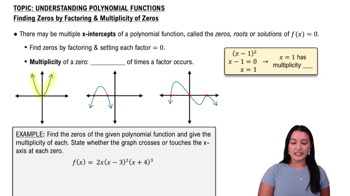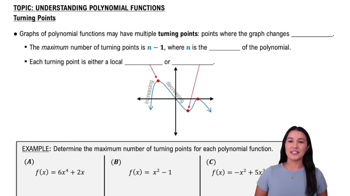Table of contents
- 0. Fundamental Concepts of Algebra3h 29m
- 1. Equations and Inequalities3h 27m
- 2. Graphs1h 43m
- 3. Functions & Graphs2h 17m
- 4. Polynomial Functions1h 54m
- 5. Rational Functions1h 23m
- 6. Exponential and Logarithmic Functions2h 28m
- 7. Measuring Angles40m
- 8. Trigonometric Functions on Right Triangles2h 5m
- 9. Unit Circle1h 19m
- 10. Graphing Trigonometric Functions1h 19m
- 11. Inverse Trigonometric Functions and Basic Trig Equations1h 41m
- 12. Trigonometric Identities 2h 34m
- 13. Non-Right Triangles1h 38m
- 14. Vectors2h 25m
- 15. Polar Equations2h 5m
- 16. Parametric Equations1h 6m
- 17. Graphing Complex Numbers1h 7m
- 18. Systems of Equations and Matrices3h 6m
- 19. Conic Sections2h 36m
- 20. Sequences, Series & Induction1h 15m
- 21. Combinatorics and Probability1h 45m
- 22. Limits & Continuity1h 49m
- 23. Intro to Derivatives & Area Under the Curve2h 9m
4. Polynomial Functions
Understanding Polynomial Functions
Struggling with Precalculus?
Join thousands of students who trust us to help them ace their exams!Watch the first videoMultiple Choice
The given term represents the leading term of some polynomial function. Determine the end behavior and the maximum number of turning points. 4x5
A
Right side rises; Ends are opposite & 4 maximum turning points
B
Right side rises; Ends are opposite & 5 maximum turning points
C
Right side rises; Ends are the same & 4 maximum turning points
D
Right side falls; Ends are opposite & 4 maximum turning points
 Verified step by step guidance
Verified step by step guidance1
Identify the leading term of the polynomial, which is \(4x^5\). The leading term determines the end behavior of the polynomial.
Determine the degree of the polynomial. The degree is the highest power of \(x\) in the polynomial, which is 5 in this case.
Since the degree is odd (5), the ends of the polynomial will behave oppositely. This means one end will rise and the other will fall.
Examine the leading coefficient, which is 4. Since it is positive, the right side of the graph will rise.
Calculate the maximum number of turning points. A polynomial of degree \(n\) can have at most \(n-1\) turning points. Therefore, a polynomial of degree 5 can have up to 4 turning points.

 6:04m
6:04mWatch next
Master Introduction to Polynomial Functions with a bite sized video explanation from Patrick
Start learning




